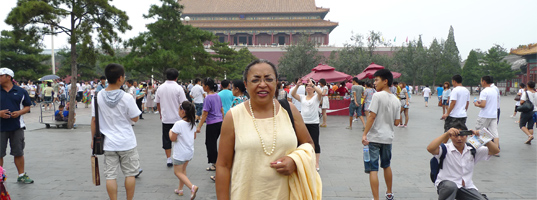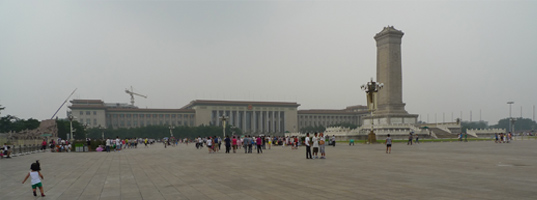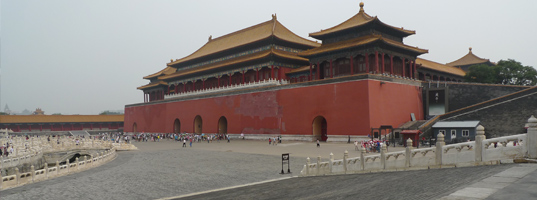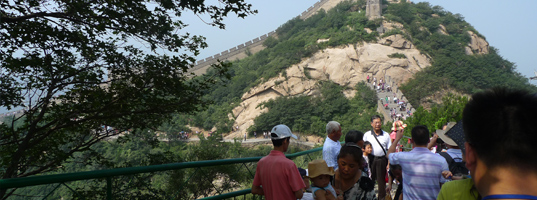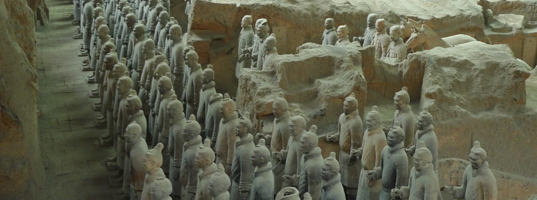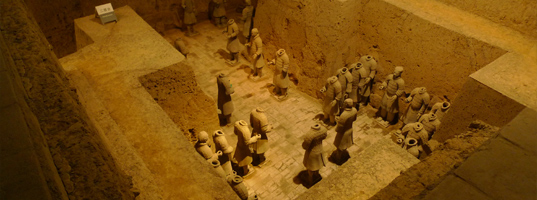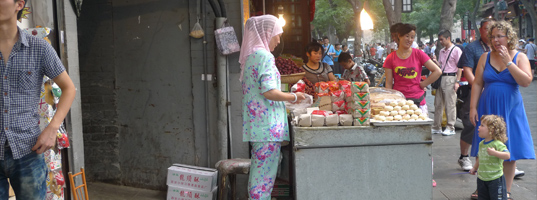In August 2011, I had the unique opportunity to travel to China to co-present a three-day workshop on “Museum Standards and Best Practices.” The American Association of Museums (AAM) was invited by the Chinese Museum Association along with Chinese State Administration of Cultural Heritage (SACH) to conduct a training session that included the translation of several AAM publications. As a Museum Accreditation Commissioner, my role was to emphasize what actually happens in institutions alongside the theoretical overviews. Julie Hart, Senior Director, Museum Standards and Excellence of the AAM conducted the workshop. Within the governmental structure, the Ministry of Culture oversees historical, cultural, art, memorials and site museums; whereas scientific, natural history and college museum are governed by other branches of government.
The ten-day trip included visits to museums, historic sites, and equally diverse dining experiences from two different regions of the country. Huang Lei, Head, Foreign Affairs & Exhibition Office from the Hunan Provincial Museum coordinated the workshop for the Chinese Museum Association. He skillfully orchestrated our ten-day experience, which included the assistance of Ms. Li Huijun and Xia Ying from the Hunan Provincial Museum who served as our translators and facilitators throughout the visit. The President of the Chinese Museum Association (CMA), Dr. Song Xinchao, is also the Vice-Director of the State Administration of Cultural Heritage.
Where to begin? The City of Beijing, the capital of the People’s Republic of China with a population of close to 30,000,000, including the 7,000,000 people designated as transients, has some of the most impressive buildings I have ever seen. The architecture utilizes space to make formidable buildings with large foot prints and breathtaking roof lines. The buildings are not New York style skyscrapers, but are very much local structures that evoke the centuries old architectural icons which preceded them. The streams of people on the streets and boulevards in late summer were enjoying school vacation by exploring Beijing’s museums and national sites. Yet, despite the crowds, there remains a calm sense of order everywhere. The presence of uniform military officers readily answering questions and quietly standing at attention was reassuring and somehow fitting to the degree of structure which is required to keep a city of thirty million on track. The site of the workshop was Tangla Beijing Hotel in West Beijing, a five-star hotel, near historic sites but directly across from the distinctive architectural structure that houses the Beijing Capitol Museum.
Over the ten-day period, the CMA arranged visits to various sites. Some of the experiences included:
Tiananmen Square: The People’s Square is 109 acres, which reportedly can hold one million people, and surrounded by iconic buildings of national importance – The National Museum of China (largest museum in the world); Tiananmen Gate built in 1419 and the tallest remaining gate in Beijing; Monument to the People’s Heroes, and Chairman Mao Zedong’s Mausoleum. One of the 21stcentury innovations in the Square are two forty-feet color LCD screens which, at the time of our visit, were showing continuous images of nature. The screens were installed for viewing the 2008 Olympics.
Tiananmen Square is bordered on the North side by the Forbidden City or Palace Museum. Built in the 1420s by the Ming Dynasty Emperor, and then later under the authority of the Qing Dynasty until 1912 when 2,000 years of a feudal monarchy system ended with the revolution headed by Dr. Sun Yat-sen. In 1987, the Palace Museum was designated by UNESCO as a World Heritage Site. The thousands of people streaming into the site that covers 7,800, 000 square feet underscored its estimated attendance of twelve million annually. It also is a result of the 2009 declaration and policy by the government that nearly 2,000 museums would have free admissions.
The National Museum of China will open fully to the public in 2012 as an administrative marriage of the Museum of Chinese Revolution and National Museum of Chinese History. One of the primary exhibitions is a visual exploration of 5,000 years of China’s history with wonderful examples of art and craftsmanship. Once fully opened, the Museum attendance will undoubtedly match or exceed the 12 million visits at The Palace Museum across the Square.
The Great Wall site that we visited is a major tourist site about a 90-minute drive from our hotel. The site overall includes a zoo and a key feature, a tram, which takes visitors up to the mountain side to a section of the Great Wall made accessible for large groups. The tram ride is short (5 to 7 minutes) and delivers you to a ticketed area where visitors walk up a moderately steep stretch of the wall. Thousands of people are climbing the wall with the goal of becoming a “hero” who makes it up to the designated landing. Our descent down was difficult, but the view of the wall hugging the mountain side was incredible. The walk down included quiet paths with many steps that were the original stone. The entire area is a tourist site that includes a theme park ride call a “slide” or a toboggan if you wanted a fast descent to the parking area and gift shops.
The Capitol Museumhas five floors of exhibitions encompassing the history of Beijing and was completed in 2006. During my short visit, I explored an exhibition on the art and craft of Chinese furniture. The design included running water and lily pads which were intended to provide an atmosphere so visitors would pause and reflect on the thoughtfulness and symbolism of each design. The most memorable aspect of the Capitol Museum’s building was the huge architectural feature which reached from the floor of the grand entrance hall, up five stores and through the exterior wall to the front of the building.
After leaving Beijing, we traveled to Xi’an, China about 750 miles inland from Beijing and a much drier environment. A major tourist attraction in the region is the tomb of the first Emperor of China, Qin Shi Haung. The formal name of the site is the Museum of Qin Terra-cotta Warriors and Horses. The striking aspect of the museum’s three archaeological pits is how technology is being used to evolve the science to better preserve the artifacts because light and air are the biggest dangers. The first pit which is the site of the 8,000 warrior figures and horses has produced volumes of information about the world of the first Emperor, and also revealed the challenges in preserving uncovered material because the color patina of the warriors disappears or loosens once exposed to the environment. UNESCO designation as a World Heritage Site was awarded in 1987.
Mound tombs are scattered across the landscape near Xi’an with the newest interpretative site being underground Hangyangling Museum with glass floor walking and viewing areas that permit visitors to view the air-conditioned dig sites with the least amount of danger to the objects. The 12-15 inch figures unearthed in the Tomb of Emperor and Empress Jingdi represented court life. The human figures for example were once clothed warriors; other figures include maidens, domestic animals, and an array of cooking utensils. The visitor experience was augmented with a 3D film that highlights the scientific discovery and the history of the Emperor Jingdi.
The Muslim community in Xi’an near the Drum Tower held the most surprises notably being The Great Mosque and the Muslim Quarter along with a thriving commercial area of shops, restaurants, farmer produce, and vendors of various products. Women’s and men’s attire referenced cultural practices in other parts of the Islamic world, women’s head scarfs for example, but there was a distinctiveness that evoke a Muslin world dating back to the thousands of years old silk trading routes that spanned Asia, India, China and Europe. The thriving streets and alley ways in the Muslim community had a resilience that centuries of endurance could only create.

